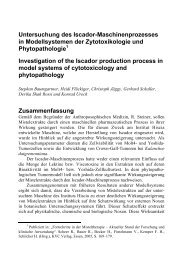Documentation of published clinical trials and ... - Institut Hiscia
Documentation of published clinical trials and ... - Institut Hiscia
Documentation of published clinical trials and ... - Institut Hiscia
Create successful ePaper yourself
Turn your PDF publications into a flip-book with our unique Google optimized e-Paper software.
Quality <strong>of</strong> Life / Pain 3.7<br />
Heusser P. et al. (2006) Palliative in-patient cancer treatment in an anthroposophic hospital:<br />
I/II. Forschende Komplementärmedizin 13 (2/3).<br />
Study design<br />
Design 1-arm, prospective, longitudinal study concerning quality <strong>of</strong> life (QoL) <strong>of</strong><br />
cancer patients before, during <strong>and</strong> after treatment in an anthroposophic<br />
clinic in Switzerl<strong>and</strong> (Lukas Klinik, LK).<br />
Patients 144 in-patients with advanced epithelial cancers. Assessment <strong>of</strong> tumourrelated<br />
therapy patterns 4 months prior to admission, during stationaly<br />
treatment (3 weeks on average) <strong>and</strong> 4 months after baseline.<br />
Assessment <strong>of</strong> QoL at admission, hospital discharge <strong>and</strong> 4 months after<br />
hospitalisation.<br />
Treatment Anthroposophic treatment starting at LK consisted <strong>of</strong> Iscador, other<br />
medicaments from plants or minerals given as injections, orally or<br />
external applications, baths, massage, therapeutic eurythmy, art therapy<br />
(e.g. painting, music), counselling <strong>and</strong> diet. They were applied in addition<br />
to already started or finished conventional cancer treatmens. At month<br />
4, the subjectively perceived benefit from anthroposophic therapies at<br />
LK <strong>and</strong> from conventional cancer therapy was assessed retrospectively<br />
by telephone inteview.<br />
Length <strong>of</strong> study 1995–1998.<br />
Measurements Medical <strong>and</strong> socio-demographic baseline data, conventional cancer<br />
treatments, anthroposophical treatmenst, treatment compliance, quality<br />
<strong>of</strong> life (EORTC, QLQ-C30, HADS, SELT-M).<br />
Most important results<br />
As compared to before admission, at LK some conventional treatments appeared reduced, <strong>and</strong><br />
after discharge either reascended again (chemotherapy, radiotherapy, sleeping drugs, sychoactive<br />
drugs), or remained constant (pain medication WHO I <strong>and</strong> II). Other treatments remained<br />
about the same for all three periods: hormonotherapy, corticosteroids, pain medication WHO<br />
III (opiates), antidepressants. As for anthroposophic treatment starting at LK compliance after<br />
discharge was highest with Iscador 90%, lowest with art therapy 14%; many patients remained<br />
primarily in the care <strong>of</strong> AM physicians. Compliance with anthroposophic therapies remained<br />
high <strong>and</strong> the use <strong>of</strong> other complementary therapies (CAM) low.<br />
© Verein für Krebsforschung, CH-4144 Arlesheim




